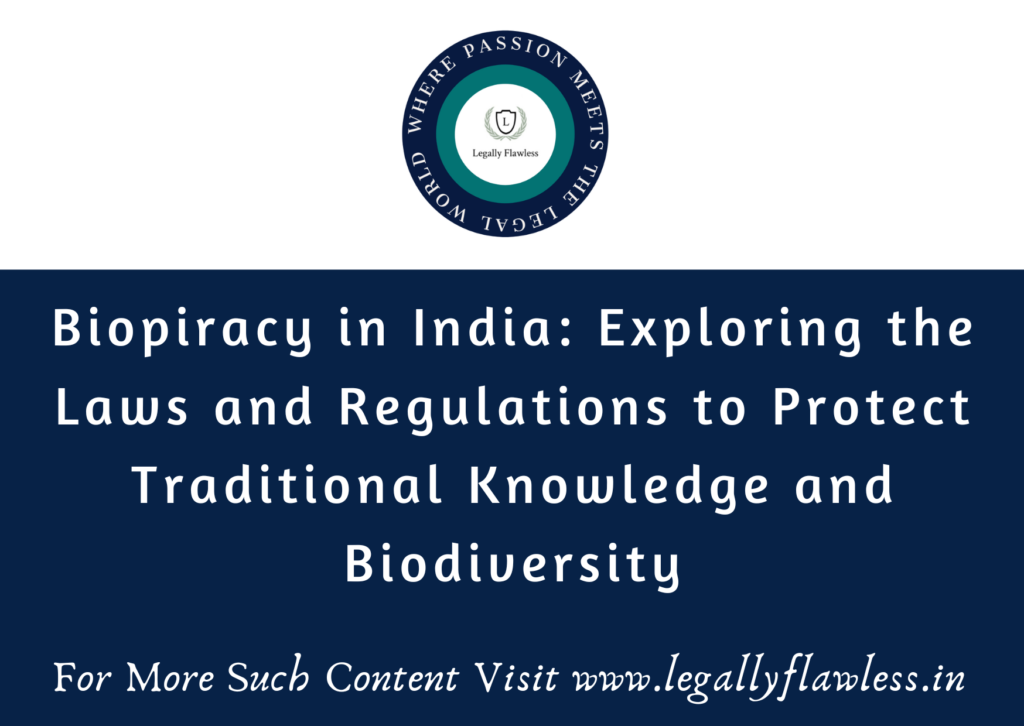
Table of Contents
Introduction
Biopiracy refers to the illegal or unauthorized acquisition of biological resources and traditional knowledge of indigenous communities by individuals or organizations, often for commercial purposes[1]. It is a serious issue in India, where the country’s rich biodiversity and traditional knowledge systems are at risk of being exploited without adequate compensation or recognition of the rights of local communities. The impact of biopiracy on Indian biodiversity is significant. It can lead to the depletion of natural resources, loss of biodiversity, and the erosion of traditional knowledge systems. Biopiracy often results in the misappropriation of genetic resources, including plants, animals, and microorganisms, which can have significant implications for the conservation of biodiversity.[2]
Biopiracy can also lead to the exploitation of traditional knowledge systems of indigenous communities without their consent or compensation. This is a violation of their rights and can result in the loss of knowledge that has been developed over generations and is essential for the conservation of biodiversity. [3]
To address the issue of biopiracy, India has developed a legal framework to protect traditional knowledge and biodiversity, including the Biological Diversity Act, 2002, and the Protection of Plant Varieties and Farmers’ Rights Act, 2001. These laws provide for access and benefit-sharing agreements and legal mechanisms to protect traditional knowledge and biodiversity. Biopiracy is a serious issue that poses a significant threat to India’s rich biodiversity and traditional knowledge systems. It is important to address this issue through legal and policy measures that recognize and protect the rights of local communities and promote the conservation of biodiversity.
Case studies of biopiracy in India and their impact on local communities
There have been several instances of biopiracy in India, where biological resources and traditional knowledge of local communities have been exploited for commercial gain without their consent or compensation. Here are some case studies of biopiracy in India and their impact on local communities:
- Basmati Rice: In the late 1990s, a US company obtained a patent on a strain of Basmati rice, claiming it as their invention. This resulted in the misappropriation of traditional knowledge of farmers in India, who had developed the strain over generations. The patent was eventually revoked, and the incident led to the introduction of a legal framework for protecting traditional knowledge in India.[4]
- Turmeric: In 1995, a US patent was granted to a researcher for the use of turmeric in wound healing. The patent claimed the invention as novel, despite turmeric being an integral part of traditional Indian medicine for centuries. The patent was eventually revoked after a legal challenge, but the incident raised concerns about the exploitation of traditional knowledge without compensation.[5]
- Neem: In the 1990s, a European company obtained a patent on a fungicidal product derived from neem trees. This patent was granted despite neem being used for medicinal and agricultural purposes in India for centuries. The patent was eventually revoked, but the incident led to the introduction of a legal framework for protecting traditional knowledge in India.[6]
- Hoodia: In 2005, a US-based company obtained a patent on the use of Hoodia, a “succulent plant” found in South Africa, as an “appetite suppressant”. However, the plant had been traditionally used by the San people of South Africa for medicinal and cultural purposes. This incident highlighted the global nature of biopiracy and its impact on indigenous communities.[7]
The impact of biopiracy on local communities is significant. It can result in the loss of traditional knowledge and resources, undermining the cultural and economic livelihoods of communities. These incidents have highlighted the importance of protecting traditional knowledge and biodiversity through legal and policy measures that recognize the rights of local communities.
The legal framework for protecting traditional knowledge and biodiversity in India.
India has developed a legal framework to protect traditional knowledge and biodiversity, recognizing the importance of safeguarding the rights of local communities and promoting the conservation of natural resources. Here are the key laws and policies in India for protecting traditional knowledge and biodiversity:
- Biological Diversity Act, 2002: This act aims to conserve India’s biological diversity and ensure equitable sharing of benefits arising out of the use of biological resources. The act provides for access and benefit-sharing agreements, requiring individuals or organizations to obtain permission from local communities before accessing biological resources or traditional knowledge. The act also establishes the National Biodiversity Authority to regulate access to biological resources and ensure the equitable sharing of benefits.
- Protection of Plant Varieties and Farmers’ Rights Act, 2001: This act recognizes the contribution of farmers and local communities in the conservation and development of plant genetic resources. It provides for the registration of plant varieties and farmers’ rights over their traditional knowledge and resources. The act also includes provisions for compensation to farmers and local communities for the use of their resources.
- Traditional Knowledge Digital Library: The Traditional Knowledge Digital Library is a database of traditional knowledge and resources, developed to prevent the misappropriation of traditional knowledge by patent offices around the world. The database contains information on traditional knowledge related to medicinal plants, yoga, and Ayurveda, among others.[8]
- National Biodiversity Authority’s Guidelines for Access and Benefit Sharing: The National Biodiversity Authority has developed guidelines for access and benefit-sharing agreements, providing a framework for the protection of traditional knowledge and the equitable sharing of benefits. The guidelines provide for the identification of local communities and their traditional knowledge, negotiation of benefit-sharing agreements, and monitoring and enforcement of agreements.
Mostly, the legal framework for protecting traditional knowledge and biodiversity in India is designed to safeguard the rights of local communities and promote the conservation of natural resources. It provides a framework for equitable sharing of benefits and recognizes the importance of traditional knowledge in the conservation of biodiversity.
Patenting of traditional knowledge
In India, traditional knowledge can be patented if it meets the patentability criteria of novelty, non-obviousness, and industrial applicability. However, there are legal implications and challenges associated with patenting traditional knowledge, such as issues of prior art, misappropriation, and exploitation.[9]
To address these issues, India has developed a legal framework for the protection of traditional knowledge, including the Traditional Knowledge Digital Library and the Traditional Knowledge Resource Classification system. These initiatives aim to prevent the unauthorized patenting of traditional knowledge by documenting and publishing it, as well as providing a basis for challenging the validity of granted patents.
The legal implications of patenting traditional knowledge in India are complex and require careful consideration of the cultural, social, and economic factors involved. The protection and preservation of traditional knowledge must balance the interests of the communities that generate it with the need to promote innovation and economic development.
Access and benefit-sharing agreements
Access and benefit-sharing agreements (ABS) are a legal mechanism in India to protect traditional knowledge and biodiversity by ensuring that the benefits derived from their use are shared fairly with the communities who generated them[10]. Under the Biological Diversity Act, 2002, ABS agreements are required for any access to biological resources or associated traditional knowledge. These agreements establish the terms and conditions for access to these resources, as well as the sharing of any benefits that arise from their use, such as royalties, research funding, or technology transfer.
ABS agreements aim to promote the conservation and sustainable use of biodiversity and traditional knowledge, while also providing economic benefits to local communities. They also encourage the responsible conduct of research and development and help to prevent the misappropriation or exploitation of traditional knowledge and genetic resources. Enforcing intellectual property rights (IPR) laws to prevent biopiracy in India can be challenging due to the complex nature of traditional knowledge and biodiversity, the lack of clear definitions and criteria for patentability, and the limited capacity of local communities and authorities to monitor and enforce IPR infringements.[11]
There is often a power imbalance between the communities that generate traditional knowledge and the companies and institutions that seek to exploit it, which can make it difficult for local communities to protect their rights and interests.
To address these above challenges, international conventions and treaties play an important role in protecting traditional knowledge and biodiversity in India. For example, the Convention on Biological Diversity (CBD) provides a framework for the conservation and sustainable use of biological diversity, as well as the fair and equitable sharing of benefits arising from the use of genetic resources.
The Nagoya Protocol, which is a supplementary agreement to the CBD, provides further guidance on ABS agreements and the sharing of benefits from the use of genetic resources and traditional knowledge. The World Intellectual Property Organization (WIPO) also offers technical assistance and capacity building programs to support the protection of traditional knowledge and biodiversity.
Conclusion
The issue of biopiracy in India is a complex one that involves multiple stakeholders, including indigenous communities, corporations, and governments. Through the case studies presented in this article, we have seen how biopiracy can have negative impacts on local communities, including economic exploitation, loss of cultural identity, and even threats to health and well-being.
However, India has taken significant steps towards protecting its traditional knowledge and biodiversity through the legal framework and policies that have been established in recent years. The Biological Diversity Act, 2002, and the Traditional Knowledge Digital Library are notable examples of India’s efforts to safeguard its natural and cultural heritage. The Patenting of Traditional Knowledge Guidelines, 2019, and the Access and Benefit-Sharing Guidelines, 2014, are also important steps towards ensuring that traditional knowledge is not misappropriated for commercial gain, and that local communities benefit from any commercial use of their resources.
However, there are still challenges that need to be addressed. The implementation and enforcement of existing laws and policies need to be strengthened to prevent biopiracy, and access and benefit-sharing agreements need to be more equitable to ensure that local communities are adequately compensated for their contributions to biodiversity conservation and sustainable use. It is important that all stakeholders work together to address the issue of biopiracy in India. Corporations need to respect the rights of indigenous communities and comply with local laws and regulations. Governments need to ensure that laws and policies are effectively implemented and enforced. Indigenous communities need to be empowered and actively involved in the conservation and sustainable use of their traditional knowledge and biodiversity.
Protecting traditional knowledge and biodiversity is critical for the long-term sustainability of India’s natural and cultural heritage, and for the well-being of local communities. By working together and building on the existing legal and policy frameworks, we can ensure that India’s rich heritage is safeguarded for future generations
A way Forward
Community-led approaches are essential for protecting traditional knowledge and biodiversity in India because local communities have a deep understanding of these resources and their sustainable use, as well as the social and cultural contexts in which they are embedded. By engaging with local communities and empowering them to take an active role in the protection and management of these resources, it is possible to promote their conservation and sustainable use, while also supporting the economic and social well-being of these communities.
To achieve this, it is necessary to build capacity and provide resources to support community-led approaches, such as training and technical assistance, access to funding and markets, and the development of local institutions and governance structures.
In addition to community-led approaches, it is also important to strengthen legal frameworks to protect traditional knowledge and biodiversity in India. This requires the development of clear and effective legal definitions and criteria for patentability, as well as the establishment of robust mechanisms for monitoring and enforcing IPR infringements.
To achieve these goals, there is a need for increased collaboration between local communities, government agencies, researchers, and industry stakeholders. This could involve the development of multi-stakeholder platforms and partnerships that bring together these different groups to share knowledge, build capacity, and develop effective policies and legal frameworks.
Overall, the way forward for protecting traditional knowledge and biodiversity in India requires a holistic and collaborative approach that empowers local communities, strengthens legal frameworks, and supports the conservation and sustainable use of these valuable resources.
This article is authored by Arghya Sen, student at Amity University, Kolkata.
[1] What is biopiracy? (2022) Unacademy. Available at: https://unacademy.com/content/neet-ug/study-material/biology/what-is-biopiracy/ (Accessed: February 15, 2023).
[2] Verma, Madhu. (2014). India Victim of biopiracy. INDO AMERICAN JOURNAL OF PHARMACEUTICAL RESEARCH. 4. 329-342.
[3] Ragnar, Johan. (2023). Biopiracy, the CBD and TRIPS – The Prevention of Biopiracy.
[4] Battle over Basmati Rice renews debate on India’s stand on Intellectual Property Rights (2012) India Today. India Today. Available at: https://www.indiatoday.in/magazine/nation/story/20010903-battle-over-basmati-rice-renews-debate-on-indias-stand-on-intellectual-property-rights-774151-2001-09-02 (Accessed: February 15, 2023).
[5] Patents: India wins a victory over turmeric but the war is on (2013) India Today. India Today. Available at: https://www.indiatoday.in/magazine/science-and-technology/story/19970908-patents-india-wins-a-victory-over-turmeric-but-the-war-is-on-832438-1997-09-07 (Accessed: February 15, 2023).
[6] PTI / Apr 1, 2005 (no date) India wins neem patent – Times of India, The Times of India. TOI. Available at: https://timesofindia.indiatimes.com/business/international-business/india-wins-neem-patent/articleshow/1067104.cms (Accessed: February 15, 2023).
[7] Wynberg, Rachel & Chennells, Roger. (2009). Green Diamonds of the South: An Overview of the San-Hoodia Case. 10.1007/978-90-481-3123-5_6.
[8] Cabinet approves widening access of the Traditional Knowledge Digital Library (TKDL) database to users, besides patent offices (no date) Press Information Bureau. Available at: https://pib.gov.in/PressReleasePage.aspx?PRID=1852528 (Accessed: February 15, 2023).
[9] S.S. Rana & Co. Advocates (2019) Understanding novelty for invention to be patentable – patent – india, Understanding Novelty For Invention To Be Patentable – Patent – India. S.S. Rana & Co. Advocates. Available at: https://www.mondaq.com/india/patent/792726/understanding-novelty-for-invention-to-be-patentable (Accessed: February 15, 2023).
[10] Editor, I. (2022) Access and benefit-sharing(abs) mechanisms, INSIGHTSIAS. Available at: https://www.insightsonindia.com/2022/12/06/access-and-benefit-sharingabs-mechanisms/ (Accessed: February 15, 2023).
[11] Introduction to access and benefit-sharing – convention on biological … (no date). Available at: https://www.cbd.int/abs/infokit/brochure-en.pdf (Accessed: February 15, 2023).
[12] Battling the biopirates, (2009) 39(3) The Ecologist accessed April 2009 (6-7)
Google Scholar
Google Scholar
[14] COOMBE R., (2001). The recognition of indigenous people’s and community traditionalknowledge in International law, 14 St. Thomas Law Review.
Google Scholar
[15] EFFERTH T., BANERJEE M., (2016). Biopiracy of natural products and goodbioprospecting practice’ (2016) 23 Phytomedicine.
Google Scholar
[16] JIANG F., (2008). The problem with patents: traditional knowledge and international IPlaw, 30(3) Harvard International Review
Google Scholar
[17] SCHINDEL D.E., BUBELA T., (2015). The new age of the Nagoya Protocol, 12 NatureConservation.
Google Scholar
[18] Secretariat of the Convention on Biological Diversity, (2001). Handbook of theConvention on Biological Diversity Earthscan.
All efforts are made to ensure the accuracy and correctness of the information published at Legally Flawless. However, Legally Flawless shall not be responsible for any errors caused due to oversight or otherwise. The users are advised to check the information themselves.



Great information shared.. really enjoyed reading this post thank you author for sharing this post .. appreciated